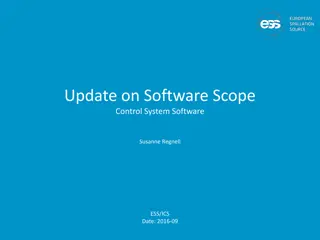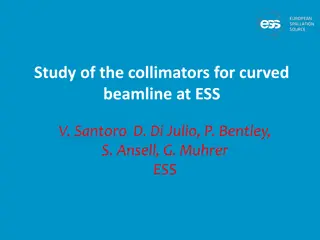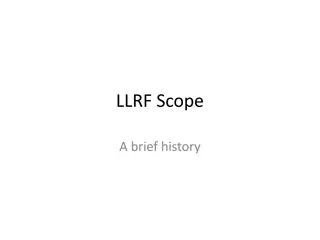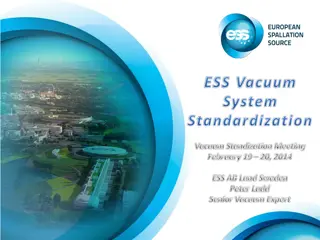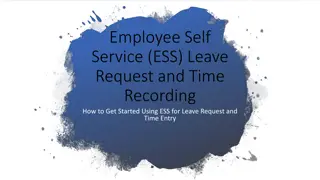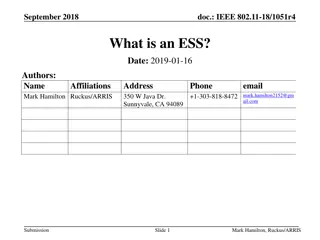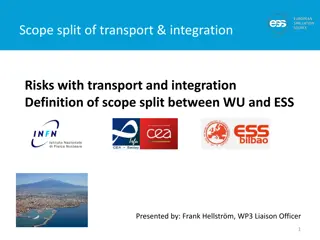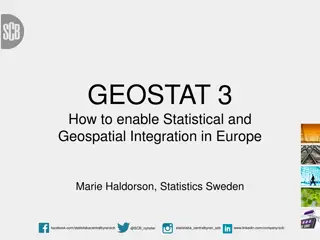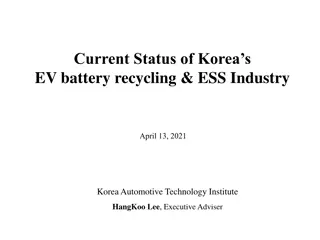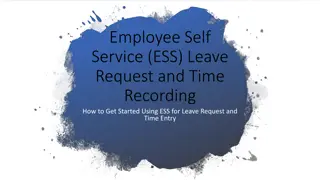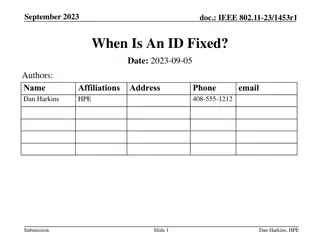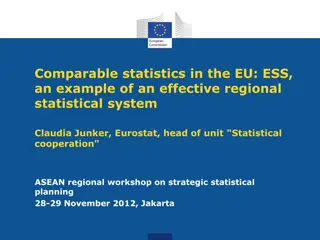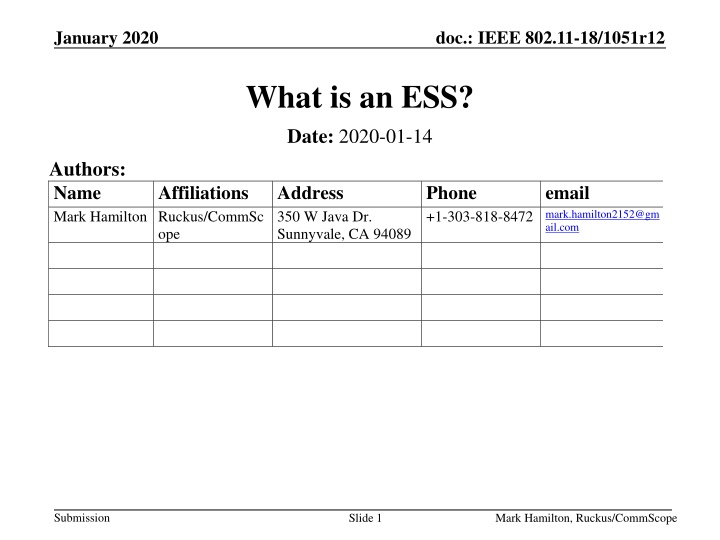
Understanding ESS in IEEE 802.11-18/1051r12 Document
Explore the concept of an ESS (Extended Service Set) in the IEEE 802.11-18/1051r12 document, discussing types, properties, mobility, and communication aspects relevant to STAs. Delve into examples like Single 802.1Q Bridged Network and HESS to grasp the practical applications within this wireless communication standard.
Download Presentation

Please find below an Image/Link to download the presentation.
The content on the website is provided AS IS for your information and personal use only. It may not be sold, licensed, or shared on other websites without obtaining consent from the author. If you encounter any issues during the download, it is possible that the publisher has removed the file from their server.
You are allowed to download the files provided on this website for personal or commercial use, subject to the condition that they are used lawfully. All files are the property of their respective owners.
The content on the website is provided AS IS for your information and personal use only. It may not be sold, licensed, or shared on other websites without obtaining consent from the author.
E N D
Presentation Transcript
January 2020 doc.: IEEE 802.11-18/1051r12 What is an ESS? Date: 2020-01-14 Authors: Name Mark Hamilton Ruckus/CommSc ope Affiliations Address 350 W Java Dr. Sunnyvale, CA 94089 Phone +1-303-818-8472 mark.hamilton2152@gm email ail.com Submission Slide 1 Mark Hamilton, Ruckus/CommScope
January 2020 doc.: IEEE 802.11-18/1051r12 Abstract Ongoing discussion re: What is an ESS? Submission Slide 2 Mark Hamilton, Ruckus/CommScope
January 2020 doc.: IEEE 802.11-18/1051r12 Goal of <x>SS discussion 802.11 needs to capture one or more types of STA mobility, and how each is communicated to the STA An <x>SS is a set of BSSs that have a common set of properties that a STA cares about. For example purposes, we consider/discuss <x>SS with at least two BSSs (== APs) so that we can discuss what is common and what is not. Chair recommendations: For each type/topic, capture a use case /purpose/context How many such contexts are there, really? How many such contexts are in our (802.11) scope? How many such contexts are already identified (ignoring what they are named)? Is there any gap or just confusion to sort? Submission Slide 3 Mark Hamilton, Ruckus/CommScope
January 2020 doc.: IEEE 802.11-18/1051r12 (Background) The 7 identified types As of Sept 2018, had concluded the 7 types ( A through G ) on the following slides (5 11). Status for further discussion, as of Sept 2018, on slide 12. Submission Slide 4 Mark Hamilton, Ruckus/CommScope
January 2020 doc.: IEEE 802.11-18/1051r12 Example <x>SS ESS What does type A do/have? : Single 802.1Q Bridged Network That is: Same subnet There may be multiple subnets, but a given client sees a consistent subnet (or set of subnets it is using), as it moves around IP address(es) doesn t change with moving within <x>SS Transparency of location ( appears as a single BSS to UL ) One DS Can Reassociate Must have same SSID (careful!) (md D1.5 4.3.5.2) Can t necessarily FT between all APs (more than one mobility domain ) (and not just because equipment is not capable/configured, but due to real barriers such as distance) Examples: Simple, well-known ESS ; 2 buildings far enough apart to not support FT (each building has its own mobility domain ); groups of APs where there is too much latency between the groups to handle FT; <x>SS subsetted to limit number of clients within each subset that can FT (each mobility domain has limited resource requirements) Submission Slide 5 Mark Hamilton, Ruckus/CommScope
January 2020 doc.: IEEE 802.11-18/1051r12 Example <x>SS HESS (or close) What does type B do/have? : Access to the same authentication domain (RADIUS) same database (the same authentication server) Identified by (the WFA s) HESSID Not necessarily same subnet, etc. Access to the same SSPN (802.11u)?? -- Need to settle this Example: National/Worldwide chain of stores No assumption that there is a single SSID -- Do we agree this? Discovery/Selection: SSPN information ( Roaming Consortium , Visited network , NAI Realm , etc.) Connection credentials: Submission Slide 6 Mark Hamilton, Ruckus/CommScope
January 2020 doc.: IEEE 802.11-18/1051r12 Example <x>SS What does type C do/have? : Same accounting for use Need to return to this, remind ourselves of the use case/scenario that s different from type B Submission Slide 7 Mark Hamilton, Ruckus/CommScope
January 2020 doc.: IEEE 802.11-18/1051r12 Example <x>SS What does type D do/have? : Single 802.1Q Bridged Network That is: Same subnet There may be multiple subnets, but a given client sees a consistent subnet (or set of subnets it is using), as it moves around IP address(es) doesn t change with moving within <x>SS More than one DS Can t reassociate across the DSs check this in the spec May or may not have the same SSID Example: A house with two, unrelated APs (different vendor, for example), plugged into the same Ethernet switch, with the same SSID. Not a .11 concept, but a composite of separate .11 networks and a .1 concept Submission Slide 8 Mark Hamilton, Ruckus/CommScope
January 2020 doc.: IEEE 802.11-18/1051r12 Example <x>SS Mobility Domain What does type E do/have? : Single 802.1Q Bridged Network That is: Same subnet There may be multiple subnets, but a given client sees a consistent subnet (or set of subnets it is using), as it moves around IP address(es) doesn t change with moving within <x>SS One DS Can reassociate Can FT Must have same MDID Must have same SSID Submission Slide 9 Mark Hamilton, Ruckus/CommScope
January 2020 doc.: IEEE 802.11-18/1051r12 Example <x>SS What does type F do/have? : Same/consistent layer 2 security parameters Coincidentally same security Planned/assured same security Same SSID Not same 802.1Q Bridged network Not a useful concept in this discussion, just coincidental (sharing of same phone profile ) BUT, distinguishing between F and D is important Submission Slide 10 Mark Hamilton, Ruckus/CommScope
January 2020 doc.: IEEE 802.11-18/1051r12 Example <x>SS What does type G do/have? : Same Operating authorization domain (different, alternate concept:) Same operating master (e.g., DFS master, TVWS enabler, etc.) Not an <x>SS concept, but important as something else, related to regulatory domain knowledge/information PLUS enablement under that domain Submission Slide 11 Mark Hamilton, Ruckus/CommScope
January 2020 doc.: IEEE 802.11-18/1051r12 Summary/status (Sept 2018) Type A is ESS, or we should modify ESS definition until it matches within the 802.11 spec Type B is HESS, or we should modify (create) HESS definition until it matches within the 802.11 spec. (Note, we may extend into coordinating the concept with outside groups (WFA) that have similar concepts/use our facilities) Type C is unclear is this different from Type B? Type D is covered by 802.1 Standards no work to do Type E is covered by Mobility Domain . We should double- check that it matches within the 802.11 spec Type F is not useful, just coincidental - BUT, distinguishing between F and D is important Type G is not in scope it is some sort of enablement concept Do we agree to all the above? Is anything missing? Submission Slide 12 Mark Hamilton, Ruckus/CommScope
January 2020 doc.: IEEE 802.11-18/1051r12 Proposed Way forward (Jan 2020) Type A: Compare our key concepts to 802.11 s ESS and propose any changes we think will clarify/correct/complete the definition and description. Type B: Compare our key concepts to 802.11 s HESS and propose any changes we think will clarify/correct/complete the definition and description. Note, we may extend into coordinating the concept with outside groups (WFA) that have similar concepts/use our facilities. Type C: Drop it as beyond 802.11 s scope, other than the HESS concept. Type D: Discuss in clause 4, as an 802.1 concept, beyond 802.11 facilities Type E: Confirm is covered and correct in 802.11 s Mobility domain Type F: Not really a useful concept, but make distinction from Type D in clause 4 discussion. Type G: Not a type of <x>ESS , so not in scope at this point. Submission Slide 13 Mark Hamilton, Ruckus/CommScope
January 2020 doc.: IEEE 802.11-18/1051r12 Way forward (Jan 2020) Type A Type A key concepts: Single 802.1Q Bridged Network (same subnet, IP address, location transparency) One DS (can reassociate) Must have same SSID (careful!) (REVmd 4.3.5.2) REVmd definition: A set of one or more interconnected basic service sets (BSSs) that appears as a single BSS to the logical link control (LLC) layer at any station (STA) associated with one of those BSSs. REVmd 4.3.5.2: An ESS is the union of the infrastructure BSSs with the same SSID connected by a DS. The ESS does not include the DS. The key concept is that the ESS appears the same to an LLC layer as an IBSS. Submission Slide 14 Mark Hamilton, Ruckus/CommScope
January 2020 Way forward (Jan 2020) Type A (cont) doc.: IEEE 802.11-18/1051r12 Recommendations: Modify the definition of ESS: From: A set of one or more interconnected basic service sets (BSSs) that appears as a single BSS to the logical link control (LLC) layer at any station (STA) associated with one of those BSSs. To: A set of one or more basic service sets (BSSs) that are interconnected by a single distribution system (DS); an ESS appears as a single IEEE Std 802 the logical link control (LLC) sublayer. Add to subclause 4.3 some discussion of the association, as the relationship between a non-AP STA and the DS (via its particular associated AP at any point in time). Also discuss the concept of reassociation where the DS association is maintained across AP to AP transition within the ESS. (See next slide.) access domain to Submission Slide 15 Mark Hamilton, Ruckus/CommScope
January 2020 Way forward (Jan 2020) Type A (cont) doc.: IEEE 802.11-18/1051r12 Recommendations: Original text in 4.3.5.1 (the Overview subclause of the DS concepts subclause): The DS enables mobile device support by providing the logical services necessary to handle address to destination mapping and seamless integration of multiple BSSs. An access point (AP) is any entity that has STA functionality and a distribution system access function (DSAF), which enables access to the DS, via the WM for associated STAs. Change to: The DS enables mobile device support by providing the logical services necessary to handle address to destination mapping and seamless integration of multiple BSSs. An access point (AP) is any entity that has STA functionality and a distribution system access function (DSAF), which enables access to the DS, via the WM for associated STAs. To invoke this access, a non-AP STA joins a BSS and associates to the AP operating that BSS. This causes the AP to notify the DS of the non-AP STA s location within the network. The non-AP STA moves to another BSS operated by an AP connected to the same DS in another location by reassociating to this new AP. The new AP updates the DS with the non-AP STA s new location at the completion of the reassociation. The STA s location information is internal to the DS, thus STA mobility is transparent to upper layers. See 4.3.5.2 (Extended service set (ESS): the large coverage network). Submission Slide 16 Mark Hamilton, Ruckus/CommScope
January 2020 Way forward (Jan 2020) Type A (cont) doc.: IEEE 802.11-18/1051r12 Update Clause 4.3.5.2 ( Extended service set (ESS): the large coverage network ): Original text: The DS and infrastructure BSSs allow IEEE Std 802.11 to create a wireless network of arbitrary size and complexity. IEEE Std 802.11 refers to this type of network as the ESS. An ESS is the union of the infrastructure BSSs with the same SSID connected by a DS. The ESS does not include the DS. The key concept is that the ESS appears the same to an LLC layer as an IBSS. STAs within an ESS can communicate and mobile STAs might move from one BSS to another (within the same ESS) transparently to LLC. Change to: The DS and infrastructure BSSs allow IEEE Std 802.11 to create a wireless network of arbitrary size and complexity. IEEE Std 802.11 refers to this type of network as the ESS. An ESS is the union of the infrastructure BSSs with the same SSID connected by a single DS. All BSSs in an ESS have the same SSID. The ESS does not include the DS. The key concept is that the ESS appears to be a single IEEE STD 802 the LLC sublayer the same to an LLC layer as an IBSS. STAs within an ESS can communicate and mobile STAs might move from one BSS to another (within the same ESS) transparently to the LLC sublayer. Do we need to say security is the same across the ESS, or is that not required? access domain to Submission Slide 17 Mark Hamilton, Ruckus/CommScope
January 2020 doc.: IEEE 802.11-18/1051r12 Way forward (Jan 2020) Type B Type B key concepts: Access to the same authentication domain (RADIUS) same database (the same authentication server) Identified by (the WFA s) HESSID Is WFA s HESSID different? Access to the same SSPN (802.11u)?? -- Need to settle this No assumption that there is a single SSID -- Do we agree this? REVmd definition: A collection of basic service sets (BSSs), which may or may not be within the same extended service set (ESS), in which every subscription service provider network (SSPN) or other external network reachable at one BSS is reachable at all of them. REVmd discussion (11.33.2): In an infrastructure BSS, the Interworking element contains signaling for Homogeneous ESSs. The HESSID is a 6-octet MAC address that identifies the homogeneous ESS. The HESSID value shall be identical to one of the BSSIDs in the homogeneous ESS. Thus, it is a globally unique identifier that, in conjunction with the SSID, may be used to provide network identification for an SSPN. Submission Slide 18 Mark Hamilton, Ruckus/CommScope
January 2020 Way forward (Jan 2020) Type B (cont) Recommendations (and questions): Suggest changes to definition to discuss access to RADIUS? Add discussion of HESS concepts in subclause 4.3 Should those changes talk about access to and thereby to SSPN, via the RADIUS access? (Or, changes in 11.23 to expand on this?) Both 802.11 and WFA definitions talk about the fact that the same SSID is not sufficient to know this is the same wireless network Need to define what we mean by wireless network ? Should we have a mention that different SSIDs might access the same wireless network ? Do we agree with that statement? Any changes we make here should be liaised to WFA, so they are aware, and can make parallel changes (or argue with us). Related: Are WFA definitions still different from 802.11 s? (They have made some wording changes/clarifications since that claim was made.) Anything about CAG, through here? Is the domain for Reassociation (and upper-layer mobility transparency) the domain that has the same SSID (and same HESSID)? Is the domain for same hotspot ( local ) the domain that has the same HESSID, regardless of SSID? Is there a domain for hotspot from my [home] provider (worldwide)? This is really a question about roaming access (and roaming consortium, too). doc.: IEEE 802.11-18/1051r12 Submission Slide 19 Mark Hamilton, Ruckus/CommScope
January 2020 Way forward (Jan 2020) Types D & F doc.: IEEE 802.11-18/1051r12 Type D key concepts: Single 802.1Q Bridged Network More than one DS Recommendation: Add discussion in subclause 4.3 that notes that if there is not a shared DS, then reassociation (and seamless roaming ) concepts may not work. However, it could still be a single 802.1 Bridged Network, so other aspects, like same IP address, and location transparency will still apply This should be mentioned in subclause 4.3, also. Type F key concepts: Coincidentally (or planned) same/consistent layer 2 security parameters Same SSID But, not same 802.1Q Bridged network Recommendation: Note these distinctions in subclause 4.3, also: Same SSID and/or same security access are not sufficient to imply same 802.1Q Bridged network Submission Slide 20 Mark Hamilton, Ruckus/CommScope
January 2020 Way forward (Jan 2020) Types D & F (cont) doc.: IEEE 802.11-18/1051r12 Following the paragraphs changed (on previous slides) in 4.3.5.2, add a paragraph: The key concept is that the ESS appears to be a single access domain to the LLC sublayer. STAs within an ESS can communicate and mobile STAs might move from one BSS to another (within the same ESS) transparently to the LLC sublayer. For completeness of understanding, it is important to note that if multiple BSSs are configured with the same SSID, but the APs are not interconnected by a common DS, there is no guarantee of seamless mobility for STAs between those BSSs. However, such a deployment may have a common LLC sublayer interconnection, in which case, communication with location transparency to the LLC sublayer (a single access domain) is generally still possible, but such communication could be disrupted at times when a mobile STA moves between BSSs. [A mobile STA implementation needs to take this possible configuration into account.] Submission Slide 21 Mark Hamilton, Ruckus/CommScope
January 2020 doc.: IEEE 802.11-18/1051r12 Way forward (Jan 2020) General Related, but separate: Recommendation? Remove 802.2 (LLC) discussion, and substitute in 802.1 concepts (802.1Q, etc.)? Upon further review, the only references to 802.2 are unrelated to this discussion. One in a NOTE in 7.2.3.2.4, suggesting that DS updates could be implemented with 802.2 XID null frames. And there are two references in a NOTE in 9.4.2.153 that LLC headers are defined in 802.2, for understanding the concept of LLC Header removal. Neither of these are related to architecture discussions, so there are no bad/old architecture references to 802.2 anymore. Submission Slide 22 Mark Hamilton, Ruckus/CommScope
January 2020 doc.: IEEE 802.11-18/1051r12 Background/old discussion slides (scrub these for other/minor proposed changes to spec) Submission Slide 23 Slid e 23 Mark Hamilton, Ruckus/CommScope Mark Hamilton, Polycom, Inc.
January 2020 doc.: IEEE 802.11-18/1051r12 What is an ESS? Current definition depends on the relationship to LLC A set of one or more interconnected basic service sets (BSSs) that appears as a single BSS to the logical link control (LLC) layer at any station (STA) associated with one of those BSSs. That would mean a 802.1 Bridged LAN (for example) creates an ESS. Probably not what we (802.11) meant. We probably meant something about transparency of location of attachment / mobility , from whatever is using the 802.11 MAC and other entities, necessary to accomplish this? ESS == demarcation of this transparency?? Is it: Transparent to whatever upper layer is above 802.11? Includes entities beyond (above?) 802.11? (Like bridges in the 11ak scenario?) The APs have to have some common/similar configuration settings? (SSID, at least. Probably other facilities (security, etc.) and policies?) Changes to Figure 4-1: BSS s are just STAs. These ovals are BSAs. Also, should we be saying OBSA ? Submission Slide 24 Mark Hamilton, Ruckus/CommScope
January 2020 doc.: IEEE 802.11-18/1051r12 What is an ESS? (Continued) Current definition depends on the relationship to LLC A set of one or more interconnected basic service sets (BSSs) that appears as a single BSS to the logical link control (LLC) layer at any station (STA) associated with one of those BSSs. We probably meant something about transparency of location of attachment / mobility , from whatever is using the 802.11 MAC 802 Services includes other entities, necessary to accomplish this? (EAP Auth Service? Bridges (11ak)? ANQP, etc?) ESS boundary == demarcation of this transparency?? Yes, + common domain of mobility that works, including security, policy, etc., necessary for mobility that actually works. Is it: Transparent to whatever upper layer is above 802.11? No, boundary may be higher than that Includes entities beyond (above?) 802.11? (Like bridges in the 11ak scenario?) Yes, as needed The APs have to have some common/similar configuration settings? (SSID, at least. Probably other facilities (security, etc.) and policies?) Yes. Changes to Figure 4-1: BSS s are just STAs. These ovals are BSAs. Also, should we be saying OBSA ? Submission Slide 25 Mark Hamilton, Ruckus/CommScope
January 2020 doc.: IEEE 802.11-18/1051r12 What is an ESS? Direction? Straw proposal - ESS is: [Edit this list, per discussion] Set of one of more basic services sets (BSSs) Appears as a single logical network, to layers above the ESS boundary The boundary might be above 802 (above Layer 2), or might be within Layer 2 (the MAC SAP, etc.) The boundary must exist/be clear for participating end stations (see 802 O&A), and external devices that can interwork with the participating end stations Provides transparency of location of attachment / mobility , as seen by layers above the ESS boundary, on both participating end stations and external end stations. Includes all entities necessary to provide the services and transparency required. Has a common domain of mobility and a common security and policies and configuration necessary to deliver the transparency from mobility. Submission Slide 26 Mark Hamilton, Ruckus/CommScope
January 2020 doc.: IEEE 802.11-18/1051r12 ESS and HESS? What is an HESS (from the term HESSID )? Homogenous [sic] extended service set (ESS) Is an HESS a type of ESS, or a separate (perhaps similar) concept? MSGCF has an ESSIdentifier , which is the concatenation of SSID and HESSID. Why/when do we need both? Is this related to an SSPN? No not really the SSPN is independent of any HESSID assignment. SSPN is a destination where I am being taken to. See Figure R-2. (Also, in figure R-2 and Figure 4-8, the AAA server/client look to be in the data path this doesn t make sense. Ans, why are the BSSs not labeled BSSs?) Submission Slide 27 Mark Hamilton, Ruckus/CommScope
January 2020 doc.: IEEE 802.11-18/1051r12 HESS concepts (not necessarily what 802.11 says, now) HESS purpose is to support 802.21 and/or WFA Passpoint/Hotspot 2.0 HESS is either/both consistent authentication, or equivalent access to external things HESS is identifiable by HESSID, which is globally unique (MAC Address); identifies the SP (but perhaps not one-to-one) HESS can/cannot span different ESSs or SSIDs Corollary: Which (if either) of these is related to 802.11 handoff? Homogenous is misspelled ; HESS should be introduced as a term/concept Submission Discuss off-line with WFA experts, 802.21 experts Slide 28 Mark Hamilton, Ruckus/CommScope
January 2020 doc.: IEEE 802.11-18/1051r12 Themes in types Example 802.1Q Bridged Network A Yes B Maybe C ?? One DS/ Reassociate Yes Maybe ?? FT Same RADIUS/SSPN Maybe Maybe ?? ?? Yes Same Accounting same thing, or different? ?? ?? Same security same thing or different? Some other scope, really D E F Yes Yes ?? No Yes ?/ No Yes ?? G ?? ?? ?? In the following slides, Bold text identifies the defining attributes Submission Slide 29 Mark Hamilton, Ruckus/CommScope
January 2020 doc.: IEEE 802.11-18/1051r12 Needed concepts (not necessarily what 802.11 says, now) Looked at WFA s Deployment Guidelines: In typical Wi-Fi deployments, if two APs have different SSIDs, they are considered to be different wireless networks. If two APs have the same SSID, they are considered to be part of the same wireless network. But because SSIDs are not globally administered, it is possible that two APs with the same SSID are, in fact, in different wireless networks. The homogeneous extended service set identifier (HESSID) element allows mobile devices to detect this condition. When two APs have the same SSID but from different wireless networks, the two networks have different HESSIDs. What is wireless network in this context? Concepts we need: Domain for Reassociation (and upper-layer mobility transparency) Domain for same hotspot ( local ) Domain for hotspot from my [home] provider (worldwide) Domain that uses the same security Equivalent access to external things (SSPN?) (CAG?) Submission Slide 30 Mark Hamilton, Ruckus/CommScope
January 2020 doc.: IEEE 802.11-18/1051r12 HESS concepts (not necessarily what 802.11 says, now) Homogeneous ESS attributes (should be): => Must have a globally unique identifier Set of BSSs Mobility transparency to upper layers (one DS, Reassociate) => Same HESSID => SSID is the same => all available/reachable services are the same => reachable SSPN(s) are the same, if present It s not: Submission Slide 31 Mark Hamilton, Ruckus/CommScope
January 2020 doc.: IEEE 802.11-18/1051r12 (Background) Analysis of the 7 types July 2019, more detailed analysis types A and E, and other concepts that need to be discussed, on the following slides (26 30). Submission Slide 32 Mark Hamilton, Ruckus/CommScope
January 2020 doc.: IEEE 802.11-18/1051r12 Type A analysis ( ESS ) page 1 Single 802.1Q Bridged Network That is: Same subnet There may be multiple subnets, but a given client sees a consistent subnet (or set of subnets it is using), as it moves around IP address(es) doesn t change with moving within <x>SS Transparency of location ( appears as a single BSS to UL ) Current ESS definition (REVmd) is: extended service set (ESS): A set of one or more interconnected basic service sets (BSSs) that appears as a single BSS to the logical link control (LLC) layer at any station (STA) associated with one of those BSSs. Conclusion: appears as a single BSS to the LLC layer to any STA associated (Needs Portal ) Submission Slide 33 Mark Hamilton, Ruckus/CommScope
January 2020 doc.: IEEE 802.11-18/1051r12 Type A analysis ( ESS ) page 2 One DS Mechanism for accomplishing the above, not a property (But, implies and is implied by, a single Portal (or none), to accomplish the above) Must have same SSID (careful!) REVmd 4.3.5.2: An ESS is the union of the infrastructure BSSs with the same SSID connected by a DS. The ESS does not include the DS WFA Deployment Guidelines: If two APs have the same SSID they are considered to be part of the same wireless network. But, because SSIDs are not globally administered it is possible that two APs with the same SSID are in fact in different wireless networks. Recommendation: Add clarification, somewhat like WFA s comments, to 4.3.5.2, to discuss the coincidentally the same SSID scenario. Perhaps a hint that clients need to handle this? Conclusion: Client can t (for sure) detect an ESS, but standard can discuss how it behaves. What does this mean for the requirements ( An ESS shall ) Submission Slide 34 Mark Hamilton, Ruckus/CommScope
January 2020 doc.: IEEE 802.11-18/1051r12 Type A analysis ( ESS ) page 3 Can Reassociate Just mechanism? (Does this add anything new?) Can t necessarily FT between all APs (more than one mobility domain ) (and not just because equipment is not capable/configured, but due to real barriers such as distance) Conclusion: Mobility domain is useful, and is independent of ESS, but must be a subset of an ESS. Covered as Type E. Submission Slide 35 Mark Hamilton, Ruckus/CommScope
January 2020 doc.: IEEE 802.11-18/1051r12 Type E analysis ( Mobility Domain ) Same properties as Type A, plus: Can FT Must have same MDID REVmd, subclause 3.1: mobility domain: A set of basic service sets (BSSs), within the same extended service set (ESS), that support fast BSS transitions between themselves and that are identified by the set s mobility domain identifier (MDID). Conclusion: Definition seems to cover it (assuming ESS is understood Submission Slide 36 Mark Hamilton, Ruckus/CommScope
January 2020 doc.: IEEE 802.11-18/1051r12 Remaining concepts analysis Type B ( HESS ?) Type C? Distinction between Type D and Type F, and either needed? More HESS discussion Concepts we need: Domain for Reassociation (and upper-layer mobility transparency) Domain for same hotspot ( local ) Domain for hotspot from my [home] provider (worldwide) Domain that uses the same security Equivalent access to external things (SSPN?) (CAG?) Submission Slide 37 Mark Hamilton, Ruckus/CommScope



